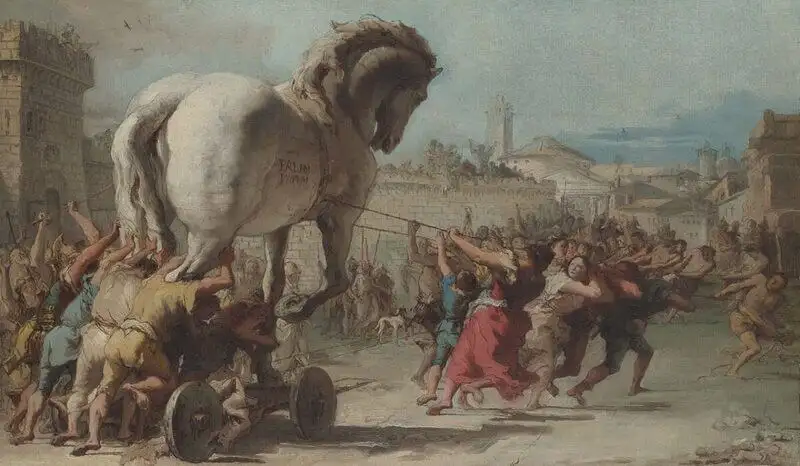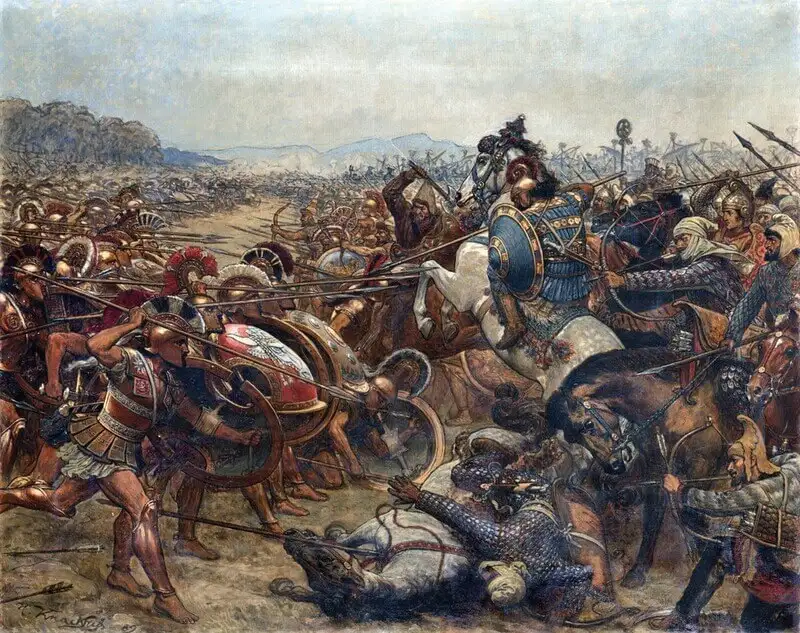The Trojan War—a Bronze Age clash between Troy and the Mycenaean Greeks—intertwines history and mythology, inspiring timeless classics like the Iliad and the Odyssey. Since the rediscovery of Troy’s ruins in the 19th century in western Turkey, archaeological evidence has revealed it as a once-powerful kingdom destroyed around 1180 BCE. In this article, Pywar takes you on a journey to explore the legendary tale of a war that has become an iconic symbol of ancient Greece.
The Story of the Trojan War
According to classical sources, the war began with the abduction (or elopement) of Queen Helen of Sparta by Prince Paris of Troy. Helen’s betrayed husband, King Menelaus, persuaded his brother Agamemnon—king of Mycenae—to lead an expedition to retrieve her. Agamemnon was joined by Greek heroes such as Achilles, Odysseus, Nestor, and Ajax, commanding a fleet of over a thousand ships from across the Greek world. They crossed the Aegean Sea to Asia Minor, besieged Troy, and demanded that King Priam return Helen.
Did You Know? Some traditions depict Homer as a blind poet, as his name resembles a Greek word for “blind” in certain dialects. In the Odyssey, a blind bard appears, recounting tales of the war, often seen as a self-portrait of the epic’s author.
The siege lasted over a decade, punctuated by battles and skirmishes, including the notable deaths of Troy’s Prince Hector and the near-invincible warrior Achilles. One morning, the Greek army withdrew from their camp, leaving behind a large wooden horse outside Troy’s gates.
Despite much debate (and unheeded warnings from Cassandra, Priam’s daughter), the Trojans brought this mysterious “gift” into their city. As night fell, the horse opened, and a group of Greek warriors, led by Odysseus, emerged to attack Troy from within.
After Troy’s defeat, the Greek heroes returned home. Odysseus endured a perilous, decade-long journey back to Ithaca, chronicled in the Odyssey. Helen, after losing two successive Trojan husbands in the war, returned to Sparta to rule alongside Menelaus. Following Menelaus’s death, some accounts suggest she was exiled to Rhodes, where a war widow hanged her in revenge.

Epics of the Trojan War
Little is known about Homer, the epic poet. Historians estimate the Iliad was completed around 750 BCE and the Odyssey around 725 BCE. Both works originated from oral traditions and were written down decades or even centuries after their composition.
Many of the most familiar tales of the war—from Helen’s abduction and the Trojan Horse to Troy’s fall—derive from a collection of epic narratives known as the “Epic Cycle,” compiled in the 6th century BCE from older oral traditions.
In the 1st century BCE, the Roman poet Virgil composed the Aeneid, the third classic epic inspired by the Trojan War. It follows a group of Trojans, led by the hero Aeneas, who flee their ravaged city, travel to Carthage, and eventually found Rome. Virgil’s aim, in part, was to craft an origin story for Rome’s first imperial dynasty, rivaling the grandeur of Greek legend.

Did the Trojan War Actually Happen?
Many elements of the Trojan War epics are challenging to assess historically. Some key figures are direct descendants of Greek gods (e.g., Helen, daughter of Zeus, who transformed into a swan to seduce her mother, Leda), and most events are driven or influenced by divine intervention.
For instance, Paris won Helen’s love after awarding a golden apple to Aphrodite for her beauty (the “Judgment of Paris” recounts how Paris was tasked with choosing the most beautiful goddess among Hera, Athena, and Aphrodite by giving her the apple). Prolonged sieges were documented in that era, but even the strongest cities could only hold out for months, not a continuous decade.
Major excavations at the site of Troy in 1870, led by German archaeologist Heinrich Schliemann, uncovered a small ancient citadel and sediment layers 25 meters deep. Subsequent studies identified over 46 construction phases across nine layers, representing habitation from 3000 BCE until its complete abandonment by 1350 CE. Recent digs reveal a living area ten times larger than the citadel, establishing Troy as a significant Bronze Age city.
Layer VIIa, dated to around 1180 BCE, contains charred debris and scattered skeletons—evidence of wartime destruction that may have inspired parts of the Trojan War story. By Homer’s time, 400 years later, Troy’s ruins were still visible.

Conclusion
Through this article, Pywar hopes to provide you with a comprehensive and insightful look at the Trojan War, a tale steeped in both history and mythology from ancient Greece. From legends of Helen’s abduction and the decade-long siege to the famous Trojan Horse stratagem, the Trojan War has become an endless source of inspiration for classics like the Iliad and Odyssey.
Translated by: Le Tuan
Source: History.com – Trojan War



